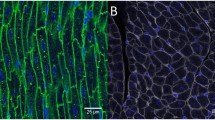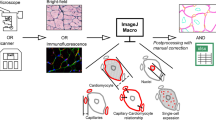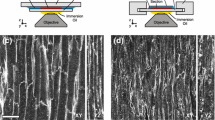Abstract
Morphological and histochemical analysis of the heart is fundamental for the understanding of cardiac physiology and pathology. The accurate detection of different myocardial cell populations, as well as the high-resolution imaging of protein expression and distribution, within the diverse intracellular compartments, is essential for basic research on disease mechanisms and for the translatability of the results to human pathophysiology. While enormous progress has been made on the imaging hardware and methods and on biotechnological tools [e.g., use of green fluorescent protein (GFP), viral-mediated gene transduction] to investigate heart cell structure and function, most of the protocols to prepare heart tissue samples for analysis have remained almost identical for decades. We here provide a detailed description of a novel protocol of heart processing, tailored to the simultaneous detection of tissue morphology, immunofluorescence markers and native emission of fluorescent proteins (i.e., GFP). We compared a variety of procedures of fixation, antigen unmasking and tissue permeabilization, to identify the best combination for preservation of myocardial morphology and native GFP fluorescence, while simultaneously allowing detection of antibody staining toward sarcomeric, membrane, cytosolic and nuclear markers. Furthermore, with minimal variations, we implemented such protocol for the study of human heart samples, including those already fixed and stored with conventional procedures, in tissue archives or bio-banks. In conclusion, a procedure is here presented for the laboratory investigation of the heart, in both rodents and humans, which accrues from the same tissue section information that would normally require the time-consuming and tissue-wasting observation of multiple serial sections.






Similar content being viewed by others
Abbreviations
- AAV9:
-
Adeno-associated virus serotype 9
- α/βMyHC:
-
α/β-Myosin Heavy Chain
- BSA:
-
Bovine serum albumin
- CHMP2B:
-
Charged multivesicular body protein 2B
- Cx43:
-
Connexin-43
- EGFP:
-
Enhanced green fluorescent protein
- FF-PE:
-
Formalin-fixed paraffin-embedded
- FP:
-
Fluorescent protein
- GFP:
-
Green fluorescent protein
- HHT:
-
Heterotopic heart transplant
- IF:
-
Immunofluorescence
- PBS:
-
Phosphate-buffered saline
- PFA:
-
Paraformaldehyde
- SMA:
-
Smooth muscle actin
- WT:
-
Wild type
References
Ausoni S, Zaglia T, Dedja A, Di Lisi R, Seveso M, Ancona E, Thiene G, Cozzi E, Schiaffino S (2005) Host-derived circulating cells do not significantly contribute to cardiac regeneration in heterotopic rat heart transplants. Cardiovasc Res 68(3):394–404
Bish LT, Morine K, Sleeper MM, Sanmiguel SJ, Wu D, Gao G, Wilson JM, Sweeney HL (2008a) Adeno-associated virus (AAV) serotype 9 provides global cardiac gene transfer superior to AAV1, AAV6, AAV7, and AAV8 in the mouse and rat. Hum Gene Ther 19(12):1359–1368
Bish LT, Sleeper MM, Brainard B, Cole S, Russell N, Withnall E, Arndt J, Reynolds C, Davison E, Sanmiguel J, Wu D, Gao G, Wilson JM, Sweeney HL (2008b) Percutaneous transendocardial delivery of self-complementary adeno-associated virus 6 achieves global cardiac gene transfer in canines. Mol Ther 16(12):1953–1959
Brejc K, Sixma TK, Kitts PA, Kain SR, Tsien RY, Ormo M, Remington SJ (1997) Structural basis for dual excitation and photoisomerization of the Aequorea victoria green fluorescent protein. Proc Natl Acad Sci USA 94(6):2306–2311
Callis G (2010) Glutaraldehyde-induced autofluorescence. Biotech Histochem 85(4):269
Chalfie M, Kain SR (2005) Green fluorescent protein: properties, applications and protocols, 2nd edn. Wiley, Haboken, pp 407–421
Chalfie M, Tu Y, Euskirchen G, Ward WW, Prasher DC (1994) Green fluorescent protein as a marker for gene expression. Science 263(5148):802–805
Chen CH, Sereti KI, Wu BM, Ardehali R (2015) Translational aspects of cardiac cell therapy. J Cell Mol Med 19(8):1757–1772
Cody CW, Prasher DC, Westler WM, Prendergast FG, Ward WW (1993) Chemical structure of the hexapeptide chromophore of the Aequorea green-fluorescent protein. Biochemistry 32(5):1212–1218
Dedja A, Dall’Olmo L, Cadrobbi R, Baldan N, Fante F, Calabrese F, Rigotti P, Ferraresso M, Delriviere L, Cozzi E, Ancona E (2005) Heterotopic cardiac xenotransplantation in rodents: report of a refined technique in a hamster-to-rat model. Microsurgery 25(3):227–234
Dedja A, Zaglia T, Dall’Olmo L, Chioato T, Thiene G, Fabris L, Ancona E, Schiaffino S, Ausoni S, Cozzi E (2006) Hybrid cardiomyocytes derived by cell fusion in heterotopic cardiac xenografts. FASEB J 20(14):2534–2536
Del Castillo P, Ar Llorente, Stockert JC (1989) Influence of fixation, exciting light and section thickness on the primary fluorescence of samples for microfluorometric analysis. Basic Appl Histochem 33(3):251–257
Diekmann H, Kalbhen P, Fischer D (2015) Characterization of optic nerve regeneration using transgenic zebrafish. Front Cell Neurosci 9:118
Dixit P, Katare R (2015) Challenges in identifying the best source of stem cells for cardiac regeneration therapy. Stem Cell Res Ther 6:26
Fasulo B, Sullivan W (2014) Live confocal analysis of mutant- and drug-treated Drosophila embryos. Methods Mol Biol 1075:243–255
Hakamata Y, Tahara K, Uchida H, Sakuma Y, Nakamura M, Kume A, Murakami T, Takahashi M, Takahashi R, Hirabayashi M, Ueda M, Miyoshi I, Kasai N, Kobayashi E (2001) Green fluorescent protein-transgenic rat: a tool for organ transplantation research. Biochem Biophys Res Commun 286(4):779–785
Heim R, Prasher DC, Tsien RY (1994) Wavelength mutations and posttranslational autoxidation of green fluorescent protein. Proc Natl Acad Sci USA 91(26):12501–12504
Isobe Y, Hou GR, Lemanski LF (1991) Deep-etching immunogold replica electron microscopy of cytoskeletal elements in cultured hamster heart cells. Anat Rec 229:415–426
Ito T, Suzuki A, Imai E, Okabe M, Hori M (2001) Bone marrow is a reservoir of repopulating mesangial cells during glomerular remodeling. J Am Soc Nephrol 12(12):2625–2635
Jockusch H, Eberhard D (2007) Green fluorescent protein as a tracer in chimeric tissues: the power of vapor fixation. Methods Mol Biol 411:145–154
Jockusch H, Voigt S, Eberhard D (2003) Localization of GFP in frozen sections from unfixed mouse tissues: immobilization of a highly soluble marker protein by formaldehyde vapor. J Histochem Cytochem 51(3):401–404
Karussis D, Petrou P, Kassis I (2013) Clinical experience with stem cells and other cell therapies in neurological diseases. J Neurol Sci 324(1–2):1–9
Kuai XL, Ni RZ, Zhou GX, Mao ZB, Zhang JF, Yi N, Liu ZX, Shao N, Ni WK, Wang ZW (2015) Transplantation of mouse embryonic stem cell-derived oligodendrocytes in the murine model of globoid cell leukodystrophy. Stem Cell Res Ther 6(1):30
Kusser KL, Randall TD (2003) Simultaneous detection of EGFP and cell surface markers by fluorescence microscopy in lymphoid tissues. J Histochem Cytochem 51(1):5–14
Kyosola K, Partanen S, Korkala O, Merikallio E, Penttila O, Siltanen P (1976) Fluorescence histochemical and electron-microscopical observations on the innervation of the atrial myocardium of the adult human heart. Virchows Arch A Pathol Anat Histol 371(2):101–119
Li X, Zhang G, Ngo N, Zhao X, Kain SR, Huang CC (1997) Deletions of the Aequorea victoria green fluorescent protein define the minimal. J Biol Chem 272(45):28545–28549
Maldonado-Soto AR, Oakley DH, Wichterle H, Stein J, Doetsch FK, Henderson CE (2014) Stem cells in the nervous system. Am J Phys Med Rehabil 93(11 Suppl 3):S132–S144
Matsunari H, Kobayashi T, Watanabe M, Umeyama K, Nakano K, Kanai T, Matsuda T, Nagaya M, Hara M, Nakauchi H, Nagashima H (2014) Transgenic pigs with pancreas-specific expression of green fluorescent protein. J Reprod Dev 60(3):230–237
Miles EL, Gorman CO’, Zhao J, Samuel M, Walters E, Yi YJ, Sutovsky M, Prather RS, Wells KD, Sutovsky P (2013) Transgenic pig carrying green fluorescent proteasomes. Proc Natl Acad Sci USA 110(16):6334–6339
Murry CE, Soonpaa MH, Reinecke H, Nakajima H, Nakajima HO, Rubart M, Pasumarthi KB, Virag JI, Bartelmez SH, Poppa V, Bradford G, Dowell JD, Williams DA, Field LJ (2004) Haematopoietic stem cells do not transdifferentiate into cardiac myocytes in myocardial infarcts. Nature 428(6983):664–668
Noonberg SB, Weiss TL, Garovoy MR, Hunt CA (1992) Characterization and minimization of cellular autofluorescence in the study of oligonucleotide uptake using confocal microscopy. Antisense Res Dev 2(4):303–313
Okabe M, Ikawa M, Kominami K, Nakanishi T, Nishimune Y (1997) ‘Green mice’ as a source of ubiquitous green cells. FEBS Lett 407(3):313–319
Ormo M, Ab Cubitt, Kallio K, Gross LA, Tsien RY, Remington SJ (1996) Crystal structure of the Aequorea victoria green fluorescent protein. Science 273(5280):1392–1395
Paez-Segala MG, Sun MG, Shtengel G, Viswanathan S, Baird MA, Macklin JJ, Patel R, Allen JR, Howe ES, Piszczek G, Hess HF, Davidson MW, Wang Y, Looger LL (2015) Fixation-resistant photoactivatable fluorescent proteins for CLEM. Nat Methods 12(3):215–218 4 p following 218
Peddie CJ, Blight K, Wilson E, Melia C, Marrison J, Carzaniga R, Domart MC, O’Toole P, Larijani B, Collinson LM (2014) Correlative and integrated light and electron microscopy of in-resin GFP fluorescence, used to localise diacylglycerol in mammalian cells. Ultramicroscopy 143:3–14
Prasher DC, Eckenrode VK, Ward WW, Prendergast FG, Cormier MJ (1992) Primary structure of the Aequorea victoria green-fluorescent protein. Gene 111(2):229–233
Schikorski T (2010) Pre-embedding immunogold localization of antigens in mammalian brain slices. Methods Mol Biol 2010(657):133–144
Shi YC, Seib PA, Lu SP (1991) Leaching of amylose from wheat and corn starch. Adv Exp Med Biol 302:667–686
Wang Y, Zhou M, Wang X, Qin G, Weintraub NL, Tang Y (2014) Assessing in vitro stem-cell function and tracking engraftment of stem cells in ischaemic hearts by using novel iRFP gene labelling. J Cell Mol Med 18(9):1889–1894
Wu JM, Hsueh YC, Ch’ang HJ, Luo CY, Wu LW, Nakauchi H, Hsieh PC (2015) Circulating cells contribute to cardiomyocyte regeneration after injury. Circ Res 116(4):633–641
Yang TT, Kain SR, Kitts P, Kondepudi A, Yang MM, Youvan DC (1996) Dual color microscopic imagery of cells expressing the green fluorescent protein and a red-shifted variant. Gene 173:19–23
Yokoyama H, Ohmi M, Murata S, Nakame T, Tabayashi K, Mohri H (1995) Proposal of a working left heart model with a heterotopic transplantation technique in rats. J Heart Lung Transplant 14(4):706–712
Zaglia T, Milan G, Ruhs A, Franzoso M, Bertaggia E, Pianca N, Carpi A, Carullo P, Pesce P, Sacerdoti D, Sarais C, Catalucci D, Krüger M, Mongillo M, Sandri M (2014) Atrogin-1 deficiency promotes cardiomyopathy and premature death via impaired autophagy. J Clin Invest 124(6):2410–2424
Acknowledgments
We thank Dr. Stefano Schiaffino for critical reading of the manuscript and support to the experiments; Drs Emanuele Cozzi, Arben Dedja and Luigi Dall’Olmo for heterotopic heart transplantation. We thank Dr Camillo Barbisan for assistance on medical legal issues inherent in the use of human samples. We are also grateful to Alessandra Dubrovich and Emilio Bigon for technical assistance. This work was supported by University of Padova (Progetto Giovani Studiosi 2010, contract: GRIC101133) to Tania Zaglia, Telethon-Italy (GGP11224) to Marco Mongillo.
Author information
Authors and Affiliations
Corresponding author
Ethics declarations
Conflict of interest
The authors declare no conflicting of interest.
Additional information
Simonetta Ausoni and Marco Mongillo have contributed equally to this article.
Electronic supplementary material
Below is the link to the electronic supplementary material.
Figure 1
Effects of the combined ‘Microwave+Triton’ treatment on tissue autofluorescence. (a–b) Hearts from GFP+ (a) and WT (b) rats were fixed by PFA perfusion. Ten µm heart sections underwent ‘microwave+Triton’ unmasking procedure and were imaged at the fluorescence microscopy using the same acquisition parameters. The images evidence that our protocol significantly blunts tissue autofluorescence without interfering with the GFP signal. (TIFF 3480 kb)
Figure 2
Secondary antibody staining in GFP positive mouse and rat heart sections. (a–c) Ventricular sections from GFP positive mice (a) and rats (b–c) underwent ‘microwave+Triton’ unmasking procedure, and were treated with 1X PBS, supplemented with 1% BSA and 1% Triton-X100 without a primary antibody, followed by incubation with anti-rabbit (a-b) and anti-mouse (c) secondary antibodies. (TIFF 14639 kb)
Figure 3
Validation of the new immunofluorescence protocol for the analysis of GFP positive mouse heart. (a–d) Immunofluorescence and microscope analysis on serial ventricular sections which underwent: no treatment (NT); microwave (Mw); Triton (Tr) or ‘microwave+Triton’ (Mw/Tr) treatments. Heart sections were stained with antibodies to: α/β-Myosin Heavy Chain (α/β-MHC) (a); desmin (b); GATA-4 (c); connexin-43 (d, cx-43). The signal of the native EGFP fluorescence upon the combination of Mw/Tr treatments is shown in the right panels (green signal). The white arrow in (c) evidences a GATA-4 positive cardiomyocyte nucleus. (TIFF 17504 kb)
Figure 4
Tissue morphology in heart sections from experimental models processed with the new immunofluorescence protocol. (a–d) Haematoxyln-eosin staining was performed in ventricular sections from heterotopic heart transplants (a–b) and hearts infected with AAV9-GFP-U6-CHMP2Bsh (c–d), before (a and c) and after (b and d) ‘microwave+Triton’ treatment. (TIFF 16867 kb)
Figure 5
Secondary antibody staining in human heart sections. (a–b) FF-PE heart sections underwent ‘microwave+Triton’ treatment and incubation with Cy3 conjugated anti-mouse (a), 488-conjugated anti-rabbit (b) and Cy3-conjugated anti-rabbit secondary antibodies, without previous incubation with specific primary antibodies. Sections were analyzed at the fluorescence microscopy. (TIFF 12676 kb)
Rights and permissions
About this article
Cite this article
Zaglia, T., Di Bona, A., Chioato, T. et al. Optimized protocol for immunostaining of experimental GFP-expressing and human hearts. Histochem Cell Biol 146, 407–419 (2016). https://doi.org/10.1007/s00418-016-1456-1
Accepted:
Published:
Issue Date:
DOI: https://doi.org/10.1007/s00418-016-1456-1




